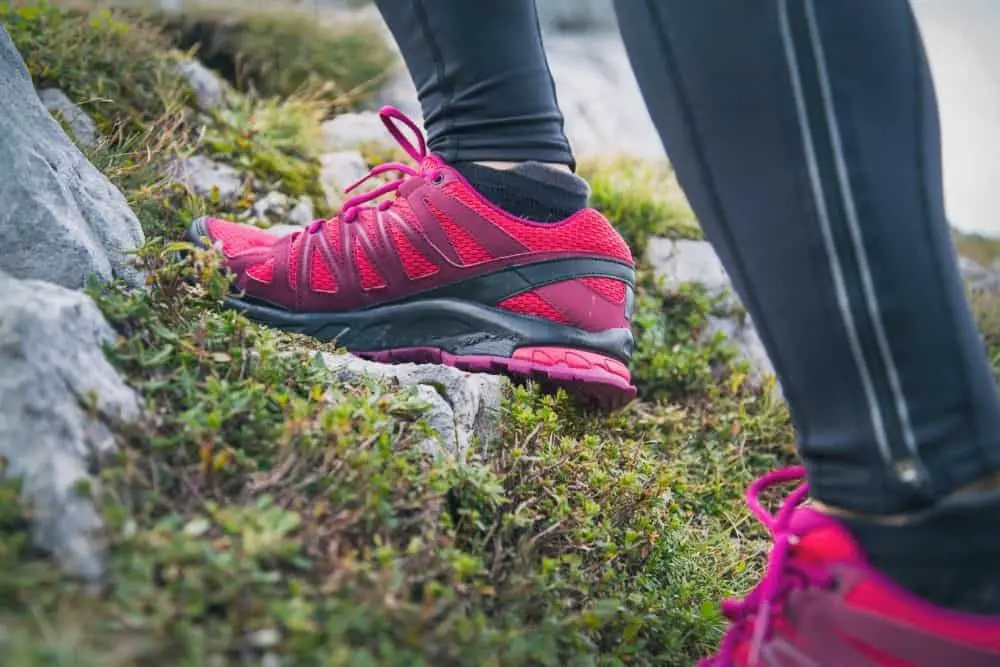Does plantar fasciitis sound new to you? Do you know that you might have been a victim of plantar fasciitis in the past without even knowing it?
Before discussing the known effects of hiking boots on plantar fasciitis, we have to first break down the meaning of plantar fasciitis into an easy-to-understand definition.
Plantar fasciitis is a common disorder that affects the connective tissue responsible for supporting the arch of the foot. This connective tissue is called plantar fascia in the medical field.
When this disorder occurs, it causes pain in the foot’s bottom and the heel. This pain is usually sterner when taking your first steps after a long period of rest or early in the morning after a good night’s sleep.
When plantar fasciitis occurs, the pain increases gradually, especially during prolonged periods of activity. Plantar fasciitis affects both feet in most cases and restricts normal foot movement in some cases.
The exact cause of this disorder isn’t known at the moment, but long periods of standing, obesity, rigorous exercise, and running are some of the suspected causes of plantar fasciitis.
But, is there a possibility that hiking boots can help or worsen plantar fasciitis? What is the relationship between the two? Read on to find out.
Contents
Do hiking boots help plantar fasciitis?
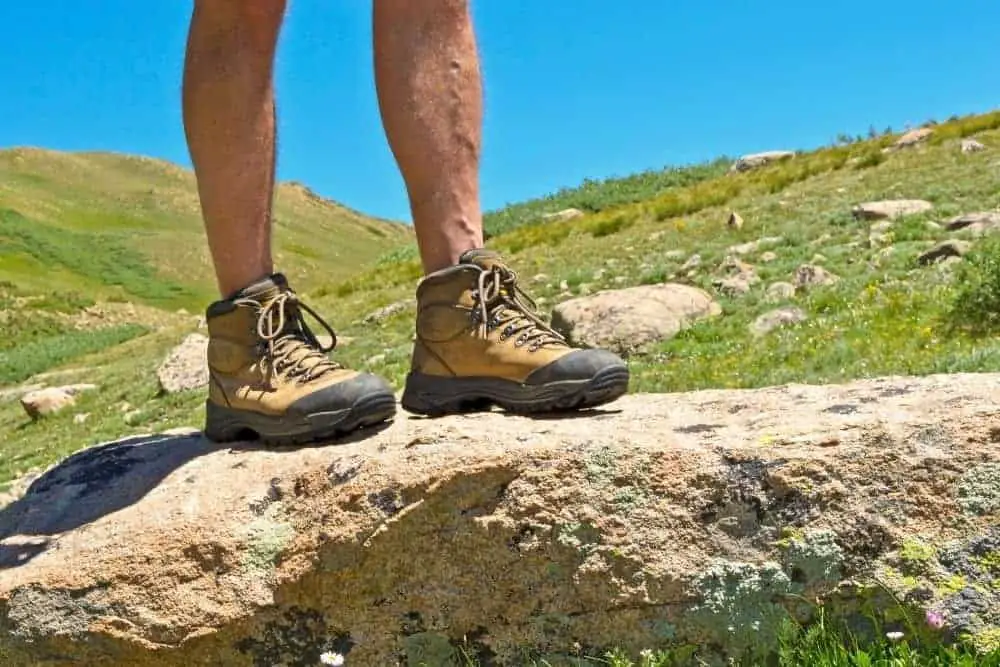
Plantar fasciitis is the inflammation of the thick band of tissues that run along the bottom of each foot. These tissues connect the heel bone to the toes.
When the tissues become inflamed, they cause stabbing pain that is usually worse with the first steps in the morning but decreases progressively as you keep walking.
Although the cause of plantar fasciitis is not fully understood, wearing poor-fitting or poorly designed boots can facilitate the development of this condition.
Poorly fitting boots or boots without adequate padding that allows your feet to feel every vibration under your feet will put more pressure on the tissues under your feet. This will definitely increase your chance of coming down with plantar fasciitis.
Plantar fasciitis has been discovered to be more common in people who are overweight. Hikers usually carry a heavy backpack which increases the pressure on their feet. If you already have faulty foot mechanics, then you are at a greater risk of developing plantar fasciitis.
When next you go shopping for a hiking boot, make sure you purchase hiking boots that lower your chance of developing this condition.
There are special hiking boots designed to prevent or cope with a foot injury like plantar fasciitis. A good number of them have great arch and ankle support.
These hiking boots are designed to adequately suit different terrain, weather conditions, and environments. They are trustworthy because they can protect the ankle from hiking injuries.
Some have Vibram soles that protect delicate parts of the foot like the plantar fascia from an intense impact while hiking on rough terrains. Buying hiking boots with enough cushioning to soften the landing of the heel on the ground will do your plantar fascia a lot of good.
However, there are times when the problem is not the fault of the hiking boot but the poor choice of the wearer. For example, when you use boots designed for smoothly paved terrains on mountainous rocky terrain, you will only be increasing your chance of developing plantar fasciitis.
The old hiking boots are also no longer support your feet well. The best way to cure your boots and your plantar fasciitis pain in this case is to insert additional insoles.

Actually, boots made for rocky terrains usually have stiffer outsoles and better-cushioned insoles to prevent your feet from all the vibrations of the rocky surface.
Finding hiking boots that are therapeutic to sore feet is not an easy task. This is why we wrote this article to save you from the stress of finding a suitable hiking boot for your plantar fasciitis.
Key features of good hiking boots for plantar fasciitis
If you are one of those that persistently suffer from plantar fasciitis, then you don’t have the luxury of picking up just any hiking boot that fits. You have to be extra cautious about your choice.
What may seem like the perfect hiking boots for the majority of those without plantar fasciitis may go terribly wrong if you try them on. This is partly the reason why it is often said that the journey to finding a good pair of hiking boots is a solitary one.
Therefore, when searching for a suitable pair of hiking boots that will minimize or prevent the exacerbation of your plantar fasciitis injury, there are features that you should not take for granted.
Once the hiking boots that you pick have the attributes we will discuss below, the number of your plantar fasciitis pain episodes will be greatly reduced. Even when you do have them, your recovery time will be a lot shorter.
1. Protection
Most hiking trails are usually rough, harsh, and unstable. Therefore, a good hiking boot designed to protect the fit from plantar fasciitis should take the hiking terrain into consideration.
For example, when hiking mountainous or rough terrain, you should always choose a pair of hiking boots with thick outsoles. Thinner soles allow your feet to feel all the vibrations from every step and this can put more pressure on your heels and toes—especially when you are on rocky terrain.
When hiking a rocky terrain, it is always important to make sure that your pair of hiking boots have ankle support. Once you have an ankle sprain, other foot injuries can follow.

In addition to protecting the feet from vibration, a good pair of hiking boots for plantar fasciitis should also protect the feet from harsh weather conditions like cold and excessive heating.
Every hiker knows that excessive heating and wetness are the two leading causes of blistering. Therefore, the right hiking boots for plantar fasciitis should be able to regulate the temperature to some extent.
When you choose a pair of hiking boots designed for a smooth paved trail for hiking a mountainous terrain, you risk increasing your chances of coming down with a foot injury.
When it comes to protection, most times the problem is not from the pair of boots but from the hiker who made the wrong choice.
2. Durability
The durability of a hiking boot is hinged on several factors such as weather condition, production material, the hiking terrain, technology used, duration of use, routine care, and storage method.
Synthetic hiking boots are more likely to cause plantar fasciitis because they are more predisposed to abrasion impairment than full-grain leather boots.
Also, it is harder to get a perfect fit with synthetic boots because they don’t stretch like leather boots. Using a pair of boots that don’t fit snugly will facilitate their spoilage as well as increase your chance of developing foot injuries including plantar fasciitis.
A hiking boot with an upper made of full-grain leather is more suitable for hiking on rocky or rough terrain. This is because leather is more resistant to wear and tear than any other known hiking boot material.
Hiking boots which wear out easily can’t be adequately used by hikers to walk very long distances. When hiking boots get old or worn out, they can strain the feet and cause problems like plantar fasciitis and other common foot injuries.
3. Flexibility
If you are already suffering from Plantar fasciitis, you should always choose hiking boots with flexible soles over the one with stiff soles. Flexible soles move with your feet so that you don’t strain your muscles or develop pressure points on your feet.
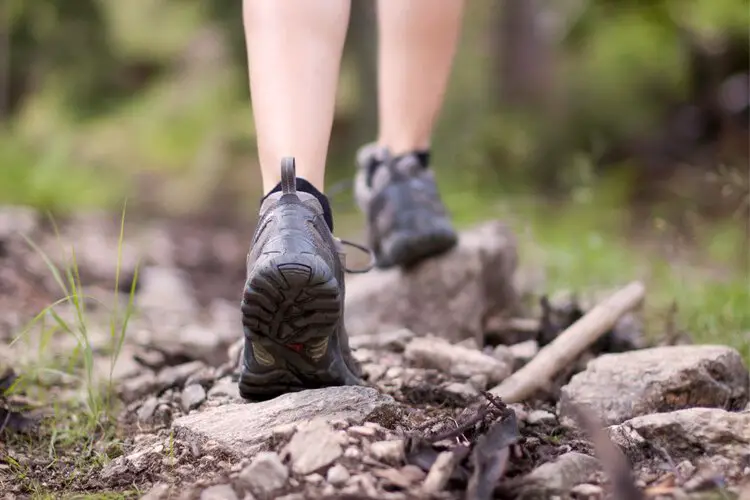
Stiff hiking boot soles might be able to provide an added layer of protection and warmth for your feet. However, it often comes with a lot of drawbacks—some of which can facilitate the development of plantar fasciitis.
Some of the major drawbacks of using stiff-soled hiking boots include:
- Due to their heavyweight, they usually feel like you are carrying a load that drains your energy
- Prevents the feet from balancing well on the ground which can often cause injuries
- Stiff soles aren’t flexible enough to safely absorb and disperse shocks away from the feet
- They can constrain the feet’s movement thereby making the feet uncomfortable in the hiking boot
- Can make you walk in unnatural ways
Stiff-soled hiking boots are suitable for use mostly in winter periods where crampons are attached to them for increased traction. If you have plantar fasciitis, it is safer to avoid hiking during this period.
This is because boots with flexible soles don’t usually work well with crampons and you may exacerbate your leg injury if you try to force it.
4. Stability
The stability of hiking boots is a function of different properties including the medial support, design, correct inserts, and proper cushioning. While some manufacturers want to stand out in the industry by creating boots with unorthodox designs, you have to be careful when going for such boots.
To test a hiking boot’s stability, simply squeeze the sides of its heel counter. When a hiking boot is stable, it naturally resists pressure and twisting.
The larger the surface area of a hiking boot’s sole just like cowboy boots, the more support it provides the foot.

Depending on the nature of your hiking terrain, you need to pay attention to how deep the grooves of your hiking boots are. You will get better stability with deep grooves in muddy and wet terrains.
When you are constantly sliding or catching your weight from crashing to the ground, you will put pressure on the toes or heels which may lead to the development of plantar fasciitis.
5. Comfort
A hiking boot that doesn’t guarantee comfort to your feet has already lost track of its intended purpose. A hiking boot that isn’t comfortable is far more likely to cause plantar fasciitis than its comfortable counterparts.
A comfortable hiking boot should be able to keep the feet cool and dry through a hiking session. An uncomfortable hiking boot can strain a hiker into consuming more oxygen, expending more energy, and even increasing general body temperature.
You can’t talk about comfort if you don’t get a right fit. That is why we will never stop emphasizing the need to purchase only boots that fit properly.
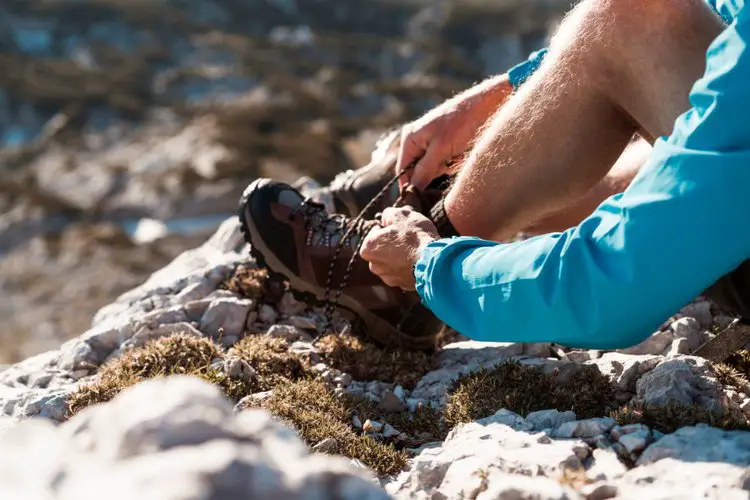
Also, before going on a hike, make sure that your boots are properly broken in. Pulling your boots out of the box and taking them for a long hike is a bad idea that can strain your feet.
Stress-related injuries like plantar fasciitis can be curtailed while hiking by using comfortable pairs of hiking boots. Shallow and narrow hiking shoes are often more likely to cause foot injuries.
For a hiking boot to be termed or labeled comfortable, it must be able to adequately handle important factors like temperature, hiker’s weight, foot sensitivity, fluctuations in muscle activity, fit, and foot shape.
6. Cushioning
A properly cushioned hiking boot must be able to absorb or redirect shock away from the feet. The amount of cushion that you will get from your hiking boots will depend on the nature and quality of the outsoles and insoles.
Oftentimes, when hiking boots are poorly designed and cushioned, they tend to direct external shocks directly to the feet instead of away from them thereby causing disorders like plantar fasciitis to easily occur.
During usage, the cushioning on hiking boots helps to dampen or reduce the external shock load transmitted to the feet. Without proper cushioning of hiking boots, the vibrations from all the elevations and depressions on your path will hit your feet like a thousand needles.
Proper cushioning of the midsole is very important in hiking boots because when the midsole is properly cushioned, the arch of the feet where the plantar fascia is located remains relaxed and the chances of plantar fasciitis ever occurring are generally reduced.
You must be vigilant about the trail you hike on because proper cushioning of hiking boots doesn’t make your feet indestructible. Cushioning has a limit to the number of hits and shocks it can protect your feet from.
There are specialized insoles sold separately which we will advise you to get if your boots don’t offer the amount of cushion that you need. These inserts can make all the difference in what your feet experience after every hike.
7. Hiking Boot’s Weight
The weight of a hiking boot is usually determined by the nature of the material used in making the boots and how many components it has. The more the component of a boot, the heavier it will likely be.
That explains why a high-cut hiking boot is heavier than a low-cut hiking boot. The heavier your hiking boots, the more energy your leg will need to lift it off the ground which can often lead to muscle pulls and other foot injuries.
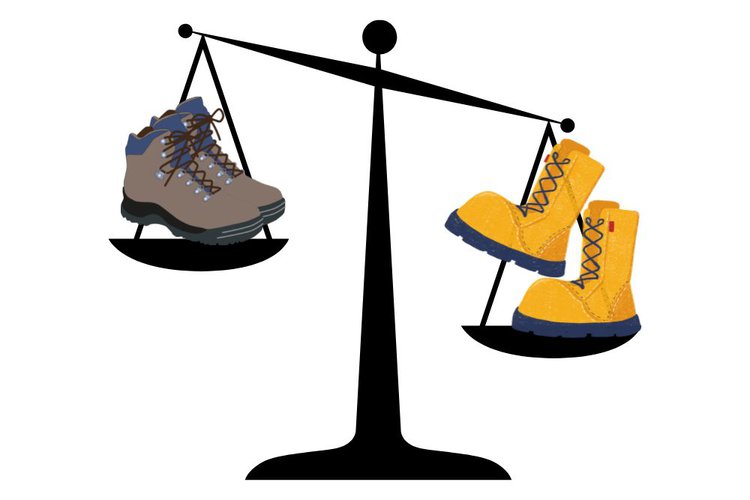
However, a hiking boot’s weight is not always a bad thing because it plays a major role in guaranteeing the overall safety and protection it will offer to your feet. You can still get plantar fasciitis from lightweight boots—in fact, many hikers have reported that.
Even though heavier hiking boots can strain the arch of the foot and cause injuries, on the flip side, they can also provide added ankle support and stability regardless of the terrain you might be hiking on.
The most sensible thing to do is to find a balance. So, never sacrifice other cool features and perfectly fitting boots just because it is slightly heavy.
8. Breathability
The breathability of hiking boots depends on the material used in making them. Leather is usually less breathable than synthetic materials.
Knitted nylon mesh is a popular synthetic material used in making hiking shoes because it is quite breathable. When boots are breathable, they allow efficient circulation of air in the boots which helps to keep your feet cool and dry.
When a hiking boot is poorly designed without a thought on breathability, there will be heat buildup in the boots. This will cause the feet of the hiker to sweat more than usual.
Excessive sweating will cause the inside of the boots to become wet which can cause an increase in stress when walking. This increase in stress can lead to foot injuries including blisters and plantar fasciitis.
In addition to the material, some manufacturers are upping their game by creating breathable boots using moisture-wicking technologies. You can further keep your feet dry by using moisture-wicking socks.
However, simple perforated designs on the upper of a hiking boot can also increase its breathability. But, the perforations will make them less suitable for hiking on wet terrains.
In summary, heat buildup will cause your feet to sweat more and the sweat will increase the chance of blistering and other foot injuries.
9. Traction
Outsole designs are responsible for the effectiveness of the hiking boot’s traction. Traction can simply be defined as the resistance to slippage.
If your hiking boots slip easily, the sliding motion will constantly put your feet under pressure. In an attempt to minimize the slip, you may be forced to alter the way you walk or to walk more cautiously.
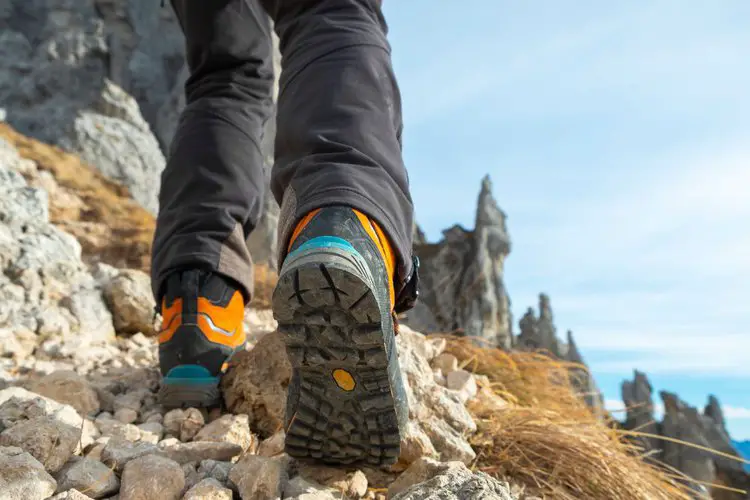
Either way, you will be increasing the stress on your leg muscles which can lead to varying foot injuries including plantar fasciitis. In the worst-case scenario, you can tumble and fall to the ground and fracture one of your bones.
Rubber outsoles are usually preferable to other outsole materials because rubber is soft, sticky, and absorbs shocks away from the arch of the foot better than most materials.
Always pay attention to the grooves on the soles of your hiking boots. As soon as the grooves start fading, you will start losing your traction.
You will either have to take the boots to a cobbler to change the soles, redraw the grooves or shop for a new pair of hiking boots altogether.
10. Fit
This is the most important aspect of buying new hiking boots and you should never take it for granted. No matter how well a hiking boot is designed, it is as good as useless if it doesn’t fit properly.
When a hiking boot is not the right size, it can cause different body problems including posture disorders, blisters, sores, and plantar fasciitis. We always recommend testing out the boots you intend to purchase.
During the test, use it to walk up and down an incline to make sure there is no form of heel lift. When your heel lifts in your boots, it puts pressure on the tissues and muscles under the foot.
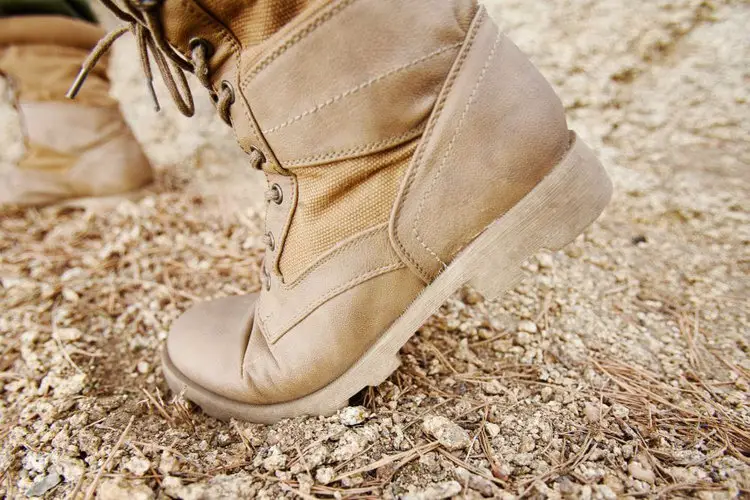
If you end up with just plantar fasciitis, then you should count yourself lucky. In the worst-case scenario, you can end up with painful blisters that will keep you on the sidelines for weeks.
To know if a hiking boot is the right fit, you must consider factors such as the volume of your foot, the width of the foot, arch length, and length from toe to heel. Below are some of the known benefits of well-fitting hiking shoes:
- Prolonged shoe life
- Added comfort and proper shock-absorption
- Proper security of the foot from harm or injuries
- Added support and stability while hiking
- Reduced frequency of plantar fasciitis
Are Keen hiking boots good for plantar fasciitis?
There are many ways of managing plantar fasciitis aside from conventional methods like a foot massage, hamstring stretch, and adequate rest. Interestingly, changing your hiking boots brand to Keen can be a gamechanger.
Using Keen hiking boots will not only help in preventing the occurrence of plantar fasciitis, but it can also cushion the intensity of the pain if it ever happens.
- WATERPROOF & PROTECTION: KEEN.DRY breathable membrane keeps feet dry and comfortable by allowing...
- MATERIAL & CONSCIOUSLY CREATED: Durable premium leather and breathable performance mesh; Quick dry...
- TRACTION: KEEN ALL-TERRAIN rubber provides high traction grip in muddy environments and on rocky...
Last update on 2023-11-11 / Affiliate links / Images from Amazon Product Advertising API
Keen hiking boots are capable of supporting the ruptured plantar fascia ligament and hastening its healing process. When you look at Keen hiking boots, you will easily discover that they have a similar look.
They all appear to curve around the middle, just before the heels. This design follows the normal curve of the human feet, thus putting less strain on your feet compared to boots with a flat design.
Also, virtually all Keen boots have a high midsole and thick padding. Also, the multidirectional lugs on the soles are usually deep and aggressive to improve traction and bring slippage to the barest minimum.
The combination of all these features increases cushion for your feet and minimizes the chances of plantar fasciitis ever occurring.
Key features of Keen hiking boots that makes them good for plantar fasciitis:
- Keen hiking boots usually have a breathable mesh lining that keeps the inside of the boots dry
- Most Keen boots are lightweight
- Have resilient internal shank
- Most of them have removable dual-density EVA footbeds for excellent arch support.
Conclusion
It doesn’t matter if you hike for fun or as a career, the fact remains that you need good hiking boots especially if you are the type that always experiences plantar fasciitis.
Comfort is key when it comes to hiking because hiking while uncomfortable in your hiking gear isn’t a pleasant experience at all and it can even lead to unexpected injuries.
Making it a priority to purchase the right kind of hiking boots will prevent unfortunate circumstances from attacking you while hiking.
Hiking boots that provide good cushioning with adequate foot support are more preferable for tackling plantar fasciitis than their counterparts.

